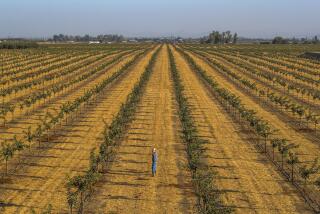California farms lead the way in almond production
- Share via
One of California’s top ambassadors often comes lightly salted and travels in a vacuum-sealed can. Eat an almond anywhere in the world and chances are that it was grown in the Golden State.
California produces 82% of the globe’s almonds, harvesting about 800,000 acres of the tree nut across a 400-mile stretch from northern Tehama County to southern Kern County.
Fueling the boom is robust foreign demand, particularly from emerging consumer markets like China and India, where the industry has been promoting almonds as a healthful snack.
About 70% of California’s almonds are sold overseas. That made the crunchy nut the No. 1 state agricultural export in 2012 at $2.5 billion. That’s 21/2 times more than wine, the second-most-valuable California agricultural export, according to the U.S. Census Bureau.
“The U.S. is the 800-pound gorilla of the global almond industry,” said Karen Halliburton Barber, assistant vice president and senior analyst for produce at Rabobank, a leading agricultural lender. “They’re the dominant producer.”
The Almond Board of California forecasts that the state will harvest its third-largest crop this year at 1.85 billion pounds — slightly less than last year’s 1.88 billion pounds.
That’s more than three times what the state was producing in the late 1990s. Experts are
optimistic that the industry can maintain that sort of volume in the coming years. Foreign
demand is expected to increase. Competition should remain light. The main barriers to continued growth are access to land and tightening water supplies.
“We’ll run out of dirt and water before we run out of almond markets,” said Daniel Sumner, director of the Agricultural Issues Center at UC Davis.
The biggest of those worries is water. Almonds are a relatively thirsty crop, and farmers need to water them even during dry spells.
California suffered its worst drought conditions in 90 years between January and May, leaving reservoirs dangerously low and state water allocations to farmers well below historical averages, according to the Bureau of Reclamation. The stingy water supplies resulted in smaller almonds this year.
“Water is a huge challenge,” said Richard Waycott, chief executive of the state almond board. The group has partnered with UC Davis to promote a variety of water conservation plans using micro sprinklers and soil moisture monitoring systems.
Growers are harvesting more almonds and using less water per acre than in years past. But the sheer acreage of California’s almond industry means water will remain a concern.
Still, with almond prices nearly doubling in the last five years to $2.58 a pound, it’s little wonder that growers have been abandoning crops such as cotton and
furiously planting almond trees. There’s twice as much almond acreage in California as there was two decades ago. Meanwhile, cotton acreage has dwindled to about 400,000 acres from 1.3 million acres over the same period.
“It feels like almonds became rock stars overnight,” said Karen Ross, secretary of the California Department of Food and Agriculture. “But they’ve been building in bits and pieces for years. I look at almonds as a great case study because they were very strategic and willing to make long-term investments.”
Central to that plan are nutritional research and clever marketing. The Almond Board of California has funded a number of studies, including an October report in the European Journal of Clinical Nutrition showing that eating dry-roasted, lightly salted almonds could sate hunger without increasing body weight.
Almonds are a major part of the farming portfolio of Beverly Hills billionaires Stewart and Lynda Resnick, who own brands such as Wonderful Pistachios, Pom Wonderful pomegranate juice and Halos mandarin oranges.
The couple’s Paramount Farming Co. has been expanding its almond acreage in Kern and Madera counties to meet growing global demand for the tree nut. It farms 46,000 acres of almond orchards, a space the size of 13 Los Angeles International airports that produces 6% of the state’s almonds.
“This is a natural place
to grow almonds,” said Joe MacIlvaine, president of Paramount Farming, surveying the company’s vast acreage in Lost Hills, a dusty flat 50 miles northwest of Bakersfield. “You need that Mediterranean-type climate or it won’t work.”
That means warm and dry weather almost year-round, and no frost during the crucial spring. That’s when the $4.8-billion industry puts its faith in honeybees to pollinate the pink-and-white flowers blooming on the almond trees.
For Paramount, that requires hiring beekeepers to deploy nearly 3 billion buzzing insects. That has become increasingly difficult and more expensive with the sudden and mysterious death of billions of bees since 2006, a phenomenon known as bee colony collapse disorder.
“Our crop is entirely dependent on them,” MacIlvaine said.
Harvesting isn’t nearly as precarious, thanks to modern machinery. In the late summer, the orchards rumble with the sound of tree shakers — low-slung vehicles equipped with padded arms that rattle the tree trunks until they rain clouds of almonds and dust.
The almonds are sent to a state-of-the-art processing facility, which shells the nuts, checks them for defects and then hand-sorts them for different grades.
The company is building a packaging and roasting plant in Lost Hills — part of its plan to sell more of its almonds directly to consumers as a packaged snack. About 40% of the company’s almonds are sold to major food companies such as Kellogg’s for use in products including cereal.
Some of the nuts are also sold to China, where annual consumption of California almonds has more than doubled in the last five years to 208 million pounds, making it the top foreign destination for the California crop.
The state almond board has an office in China, where it has invested heavily promoting the nut on billboards and in print and digital advertising as part of a youthful and healthy lifestyle.
What bodes well for the industry is that almond demand is also expanding in Europe and the U.S., shielding it from dips in consumption in any one place, said Halliburton Barber of Rabobank.
“They have a balance. It’s more than just China,” she said. “There’s still great potential to keep growing.”
More to Read
Inside the business of entertainment
The Wide Shot brings you news, analysis and insights on everything from streaming wars to production — and what it all means for the future.
You may occasionally receive promotional content from the Los Angeles Times.











